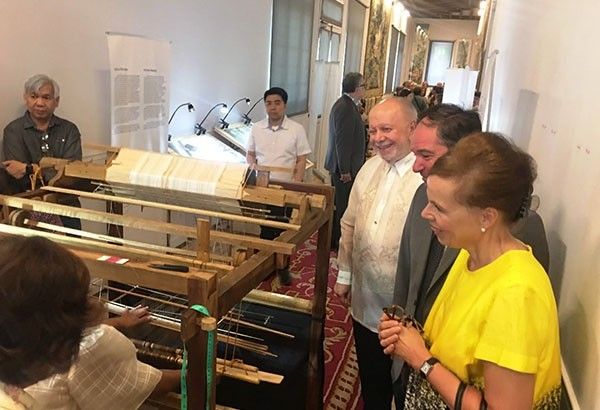Filipino embroiders’ works exhibited in Spain

MANILA, Philippines — The Philippine Embassy in Madrid and the Real Fabrica de Tapices, through the efforts of the National Museum of the Philippines, the Office of Senator Loren Legarda, and the local governments of Kalibo, Aklan and Lumban, Laguna, recently launched the “Piña-Seda: Hiblang Lahing Filipino Travelling Exhibition, Lecture Series, Weaving and Embroidery Demonstrations and Workshops” at the Real Fabrica de Tapices in Madrid, Spain.
In his welcome remarks, Real Fabrica de Tapices director-general Alejandro Klecker de Elizalde expressed satisfaction over the exhibit and its programs and noted the forthcoming 500th anniversary of Magellan’s arrival in the archipelago and the long, interlinked history of Spain and the Philippines which led to cultural exchanges such as country’s the embroidery tradition.
Ambassador Philippe Jones Lhuillier underscored the contribution of the weavers and embroiders in the preservation of the piña-seda and called them “underrated artisans” deserving of further acknowledgment. He also thanked the Real Fabrica de Tapices for choosing to work with the Philippine embassy in bringing the exhibit to Madrid, and the National Museum and Office of Senator Legarda for the initiative to shine a spotlight on Philippine textiles.
National Museum of the Philippines Director Jeremy Barns expressed his deep gratitude to the Philippine embassy in Madrid and the Real Fabrica de Tapices for hosting the exhibit, as he delivered his statement and that of Senator Legarda.
An advocate of indigenous arts and culture, Senator Legarda initiated the establishment of the first permanent textile exhibition at the National Museum of the Philippines in 2010 and her office, along with the National Museum, has been leading the promotion of Philippine textiles by bringing the exhibit to various Philippine embassies in Europe.
Around 100 people from Spain’s cultural institutions, including the Museo Naval director general, and representatives from other museums, textile researchers, members of the academe and the Filipino community witnessed the launch and took the guided tour of the piña-seda exhibit led by National Museum of the Philippines officials.
Former President and Pampanga 2nd District Representative, Gloria Macapagal-Arroyo, also visited the exhibit’s second day and witnessed a weaving and embroidery demonstration. She congratulated the persons involved in the exhibit.
The exhibit and its related activities aim to increase public awareness and interest in Filipino traditional textiles and to deepen appreciation of local weaving traditions and provide venues for the promotion of intangible heritage related to processing and weaving textiles, and knowledge exchanges. It also seeks to highlight the skills, knowledge and efforts of local weavers in preserving and upholding Filipino traditional weaving heritage.
The almost 300-year old Real Fabrica de Tapices will host the month-long Hiblang Lahing Filipino exhibition, which will close on June 21. The exhibit’s weaving demonstrations, embroidery workshops, and lecture series focused on the Philippines’ weaving traditions, and the history, social significance, and artistry of the piña-seda, arguably the Philippines’ most famous indigenous textile.



















